15 Minimalist Studio Apartment Ideas That Maximize Style and Space
Living in a studio apartment doesn’t mean you have to sacrifice style—or sanity. In fact, the limited square footage can be the perfect motivation to embrace minimalist living and design a space that’s not just beautiful, but incredibly functional too.
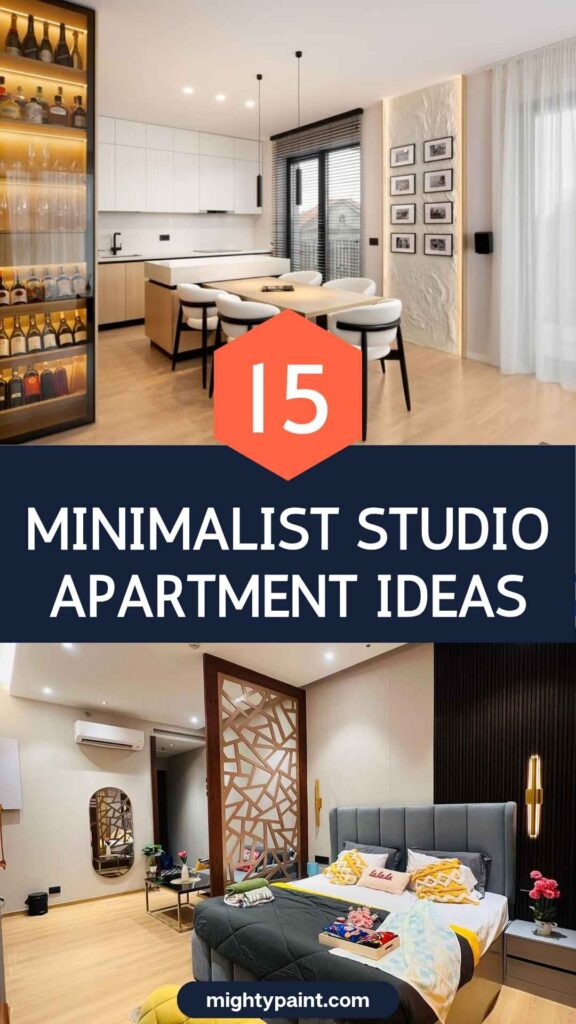
Minimalism in small spaces is all about intentionality: choosing quality over quantity, keeping visual clutter low, and making every piece count. Whether you’re starting from scratch or looking to simplify your current setup, a minimalist approach can transform even the tiniest studio into an open, airy retreat.
Get the Fail-Safe Paint Color Playbook (Free PDF)
36 proven colors • 8 ready palettes • trim & sheen guide • printable testing cards.
From clever storage solutions to versatile furniture and calming color palettes, this list of 15 minimalist studio apartment ideas will help you make the most of your space—without compromising your personal style. Clean lines, calm vibes, and smarter living start here.
1. Go All-In on a Light Color Palette

One of the simplest and most effective ways to make a studio apartment feel bigger is to embrace a light, airy color scheme. This space uses shades of white and soft neutrals throughout—from the curtains to the walls to the furniture—which reflects natural light and creates a seamless, open look.
The consistent palette visually unifies the sleeping, dining, and working zones without needing walls or dividers. It’s minimalist design at its best: calm, clean, and cohesive.
To avoid the space feeling too sterile, texture is key. A woven chair seat, a subtly patterned rug, and layered bedding all add depth while staying within the minimalist theme. For studio dwellers, this light-on-light look is a total game changer—especially when paired with smart furniture placement and good lighting.
2. Use a Glass Block Divider to Separate Zones Subtly
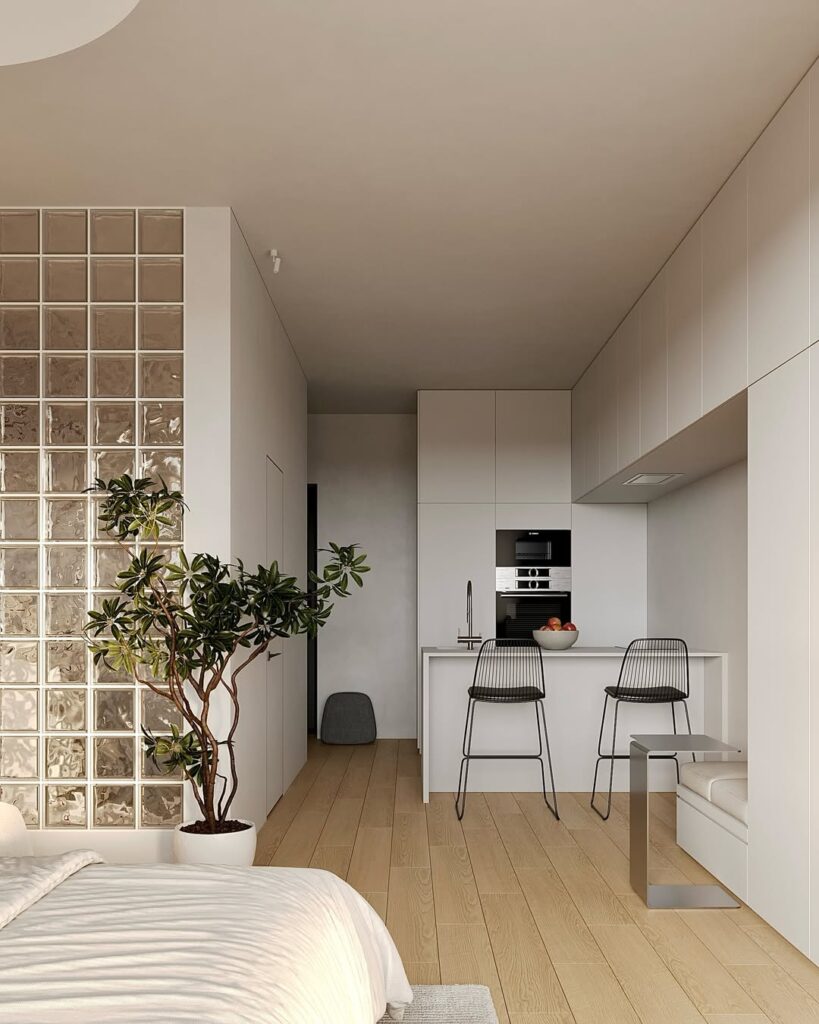
In a minimalist studio, creating distinct zones without building walls is key. This space cleverly uses a glass block divider to section off the bed from the kitchen without blocking light or breaking the visual flow.
The transparent partition keeps the space open and airy while still offering a bit of privacy—perfect for when you’re cooking or entertaining. It adds structure without clutter, fitting perfectly into a clean, modern aesthetic.
Paired with handle-free cabinets, hidden appliances, and a sleek breakfast bar, the entire layout feels polished and purposeful. It’s proof that minimalist design doesn’t have to be stark—it can be soft, smart, and beautifully functional.
3. Create Zones with Furniture and Rugs Instead of Walls
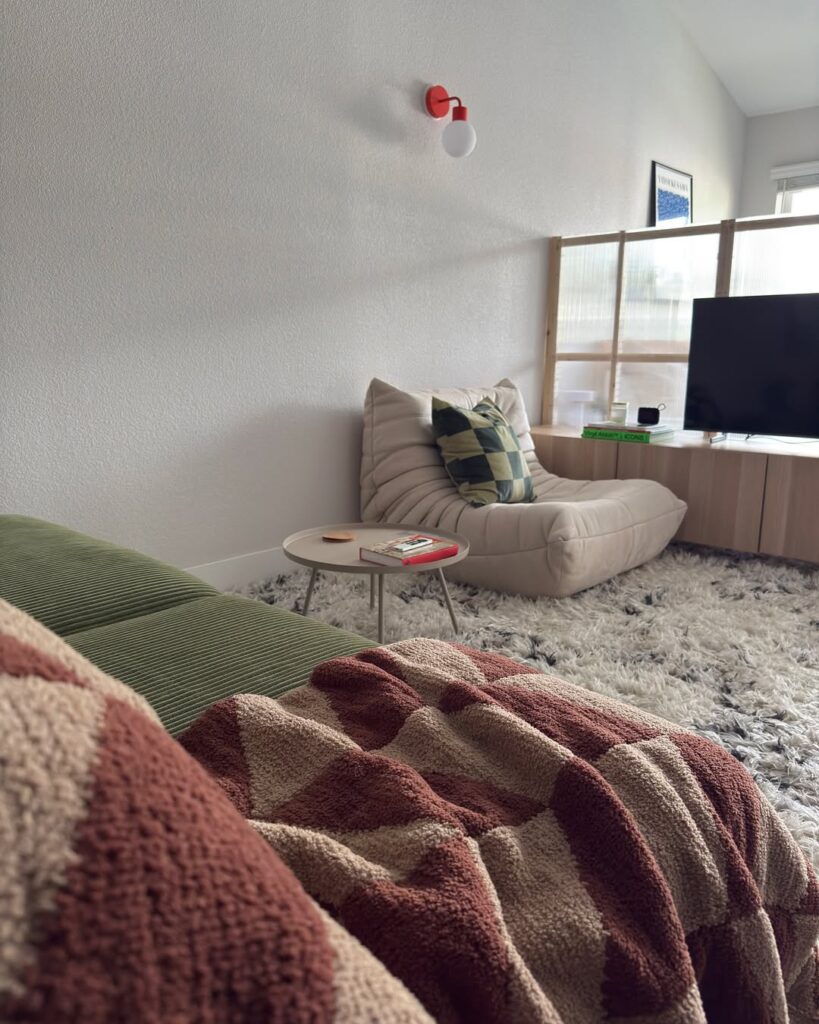
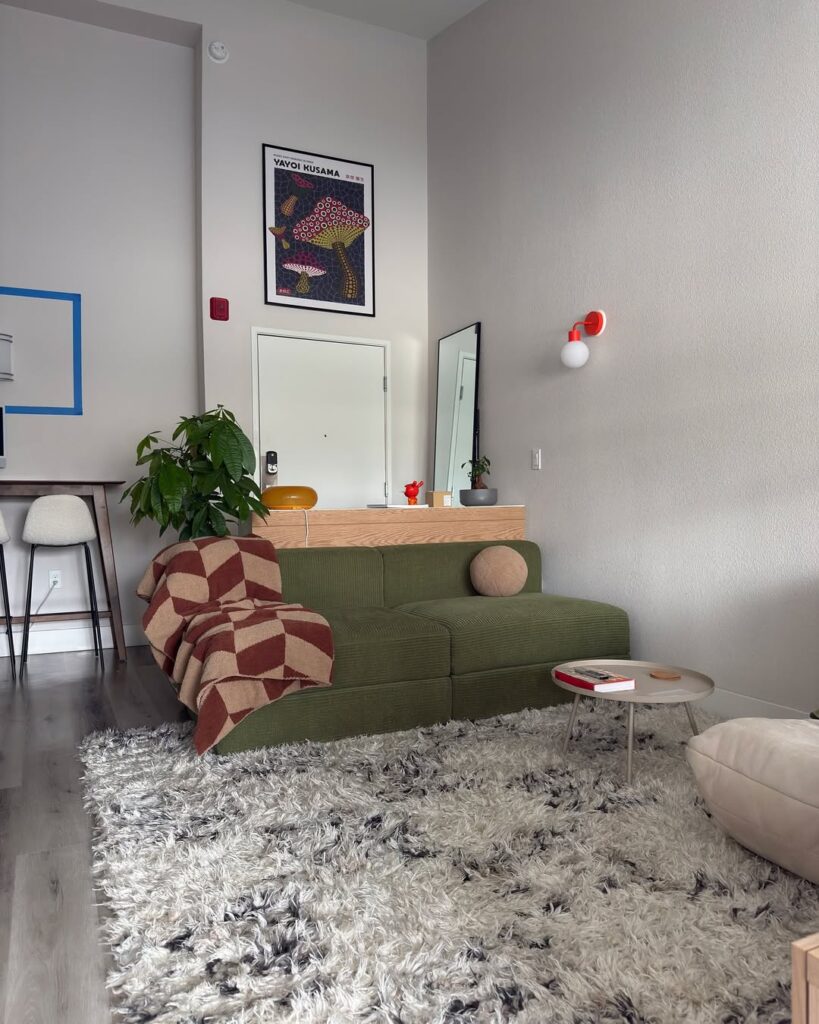

credit – @cleve.interior
This cozy studio shows how to define functional areas—like a living room or entryway—without any physical dividers. By thoughtfully positioning furniture and using a large shag rug, the seating area feels grounded and intentional, even in a shared space.
The green corduroy sofa, plush floor chair, and small round coffee table create a soft yet structured lounge zone, while the low media console and translucent room divider visually separate the living area from the sleeping space beyond.
What really works here is the layering of textures and muted, earthy tones. The geometric throw blanket, fuzzy rug, and rounded forms all soften the space, while red light fixtures add a playful, minimalist pop.
This setup proves that you don’t need big walls or complex layouts—just smart furniture placement and tactile materials to make a small apartment feel warm, livable, and effortlessly stylish.
4. Use a Slatted Wood Partition for Style and Function
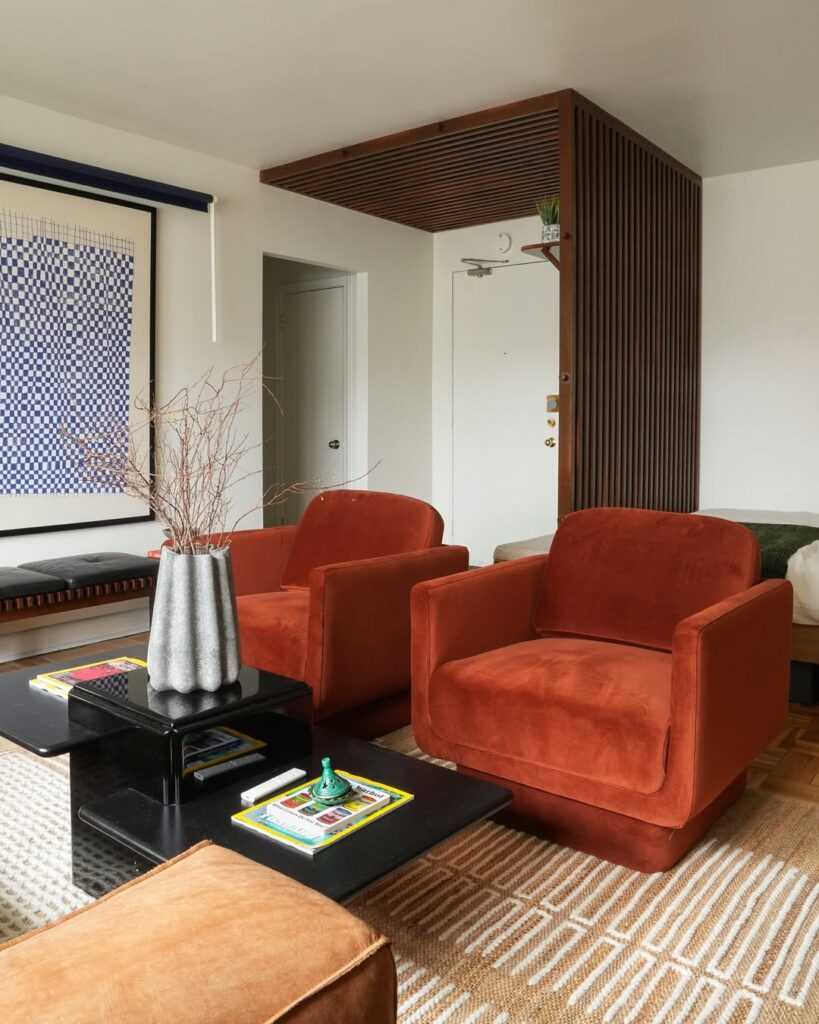
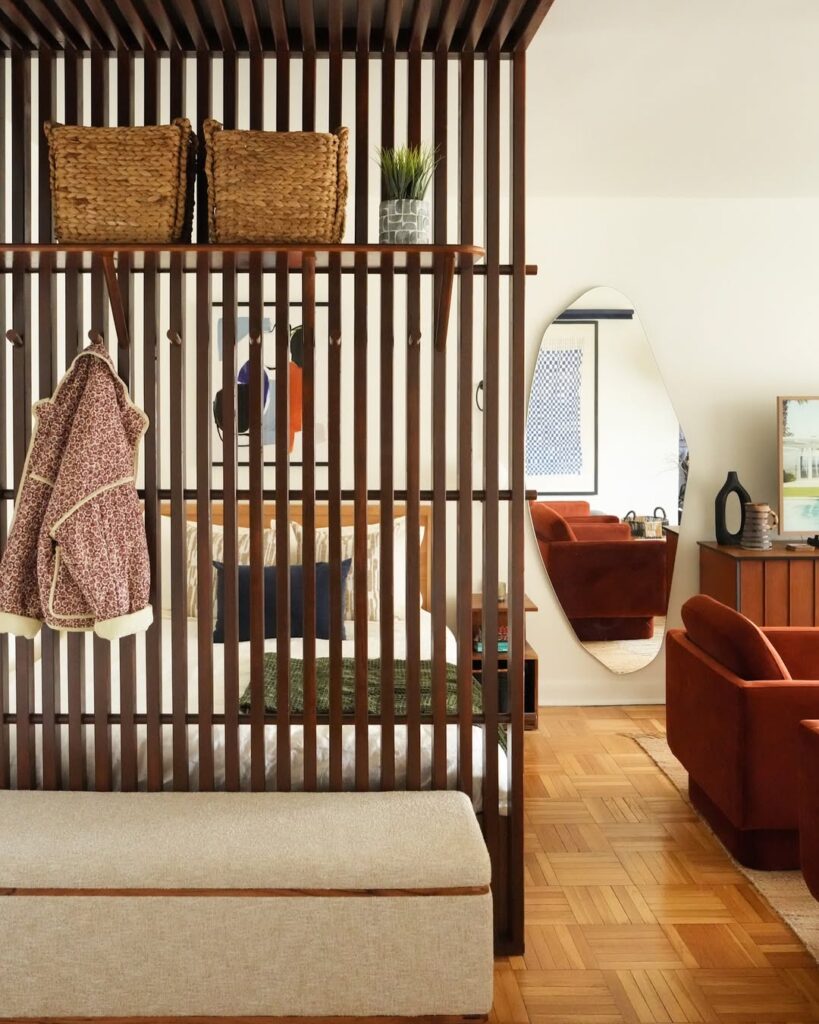
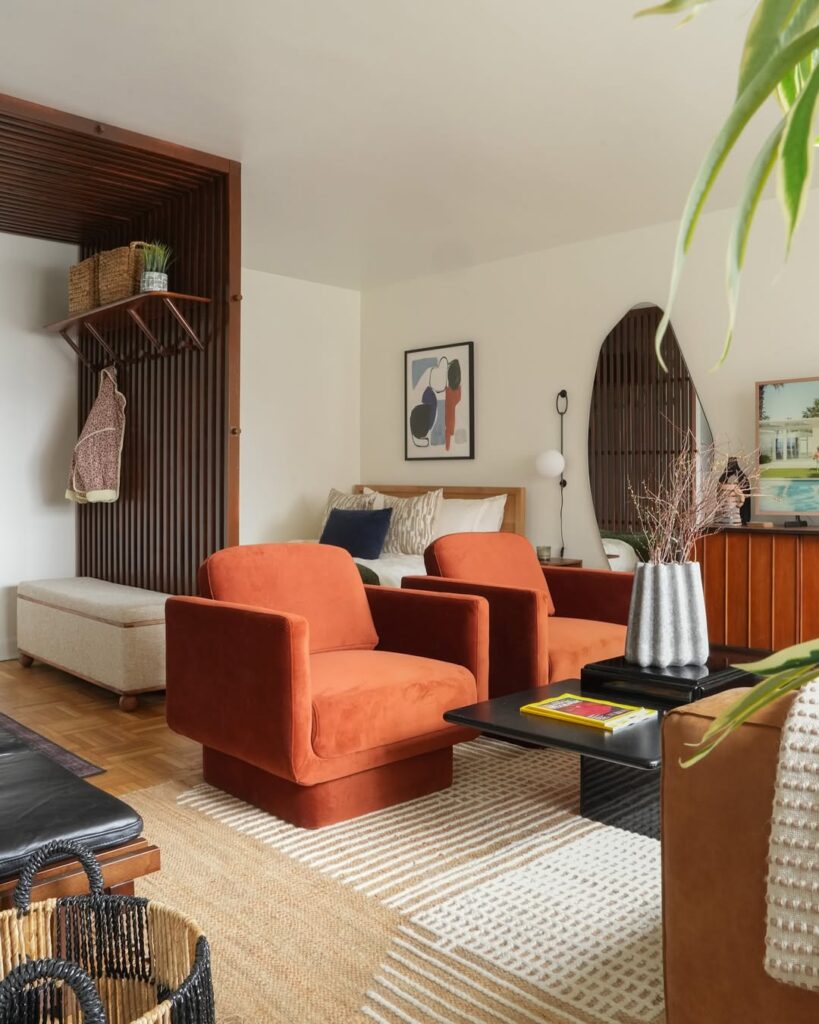
credit – @alexandragater
Get the Fail-Safe Paint Color Playbook (Free PDF)
36 proven colors • 8 ready palettes • trim & sheen guide • printable testing cards.
This studio apartment nails the balance between form and function with a custom slatted wood partition that subtly divides the sleeping and living areas. The vertical lines offer just enough privacy while maintaining airflow and light—two essentials in small spaces.
What makes this divider so effective is its multifunctionality. It serves as a coat rack, display shelf, and mini mudroom with a built-in bench. That’s minimalist living: fewer elements doing more jobs.
The rich wood tones complement the retro-inspired burnt orange chairs and warm textures throughout the room, adding depth without visual clutter. Meanwhile, clean lines and low-profile furniture keep the entire layout feeling open and modern.
If you want to create a defined bedroom area without closing off your space, this slatted approach adds architectural interest and utility in one sleek move.
5. Embrace a Low Profile for a Calm, Grounded Space
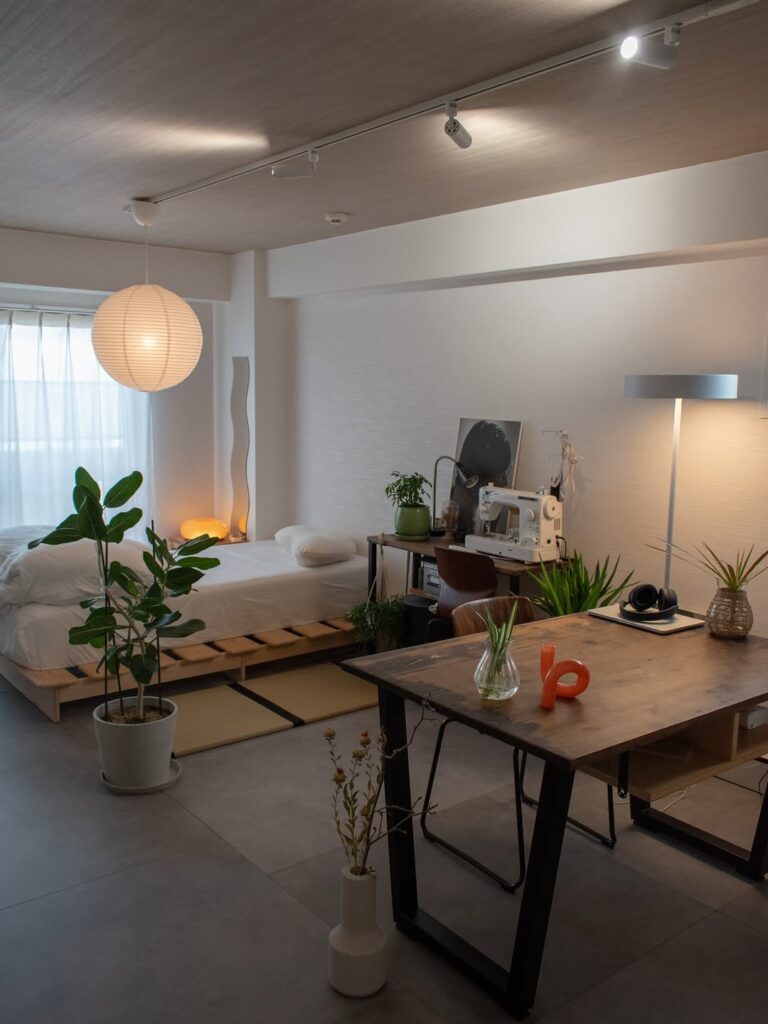
This studio uses height—or rather, the lack of it—to create a soothing, minimalist retreat. The low platform bed, flat tatami mats, and grounded furniture choices instantly make the room feel more expansive and serene.
A restrained color palette of warm neutrals and natural wood tones enhances the peaceful mood, while strategic lighting—like the soft glow from a paper lantern—adds warmth without visual noise.
Plants add life without clutter, and the workspace is simple yet functional, proving that minimalism doesn’t have to mean bare. Instead, it’s about intentional pieces that serve a purpose and contribute to the overall calm.
This setup is perfect for fans of Japanese or Scandinavian-inspired design, where less truly is more—and the floor space itself becomes part of the experience.
6. Keep It Sleek with Built-Ins and a Monochrome Base
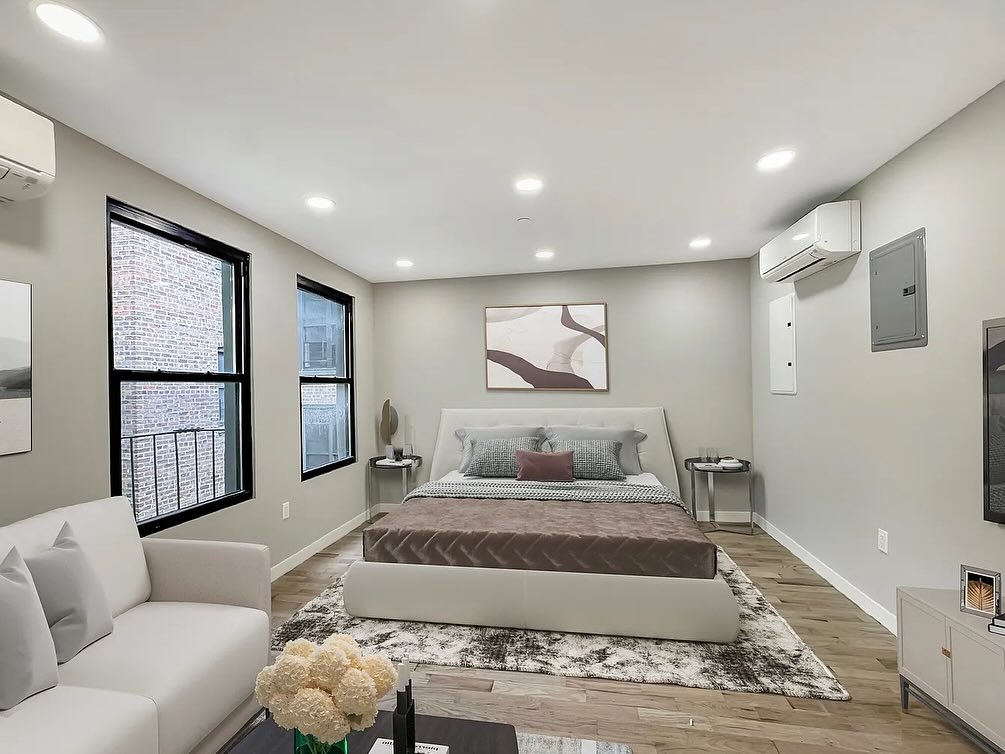
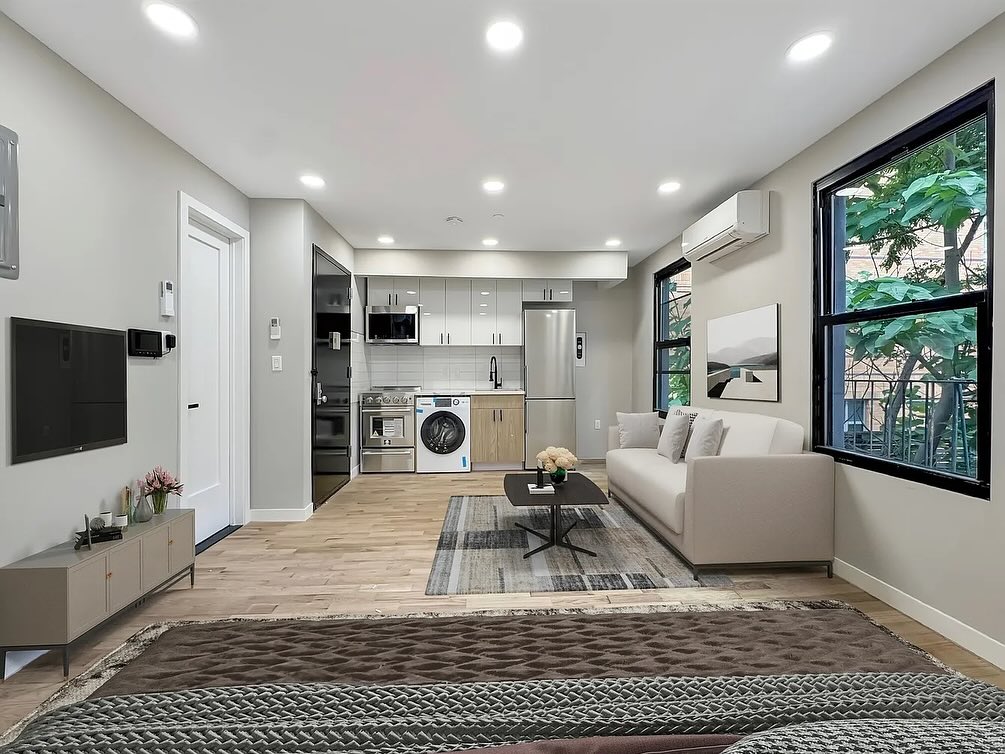
credit – @j_paredes_realtor
This studio apartment proves that minimalism doesn’t have to mean cold or empty—it’s all about streamlined choices. A monochromatic base of taupe, gray, and white sets a calming foundation while allowing architectural details and textures to shine.
The built-in kitchen cabinetry and appliances blend seamlessly into the back wall, eliminating visual clutter. Even the washer-dryer is tucked neatly into the kitchen zone, showing how smart design can make every square foot work harder.
Get the Fail-Safe Paint Color Playbook (Free PDF)
36 proven colors • 8 ready palettes • trim & sheen guide • printable testing cards.
Low-profile furniture, like the platform bed and clean-lined sofa, helps the space feel open and balanced. Carefully layered area rugs and neutral art add subtle depth without crowding the room.
This setup is ideal for small-space dwellers who want a polished, contemporary look that’s easy to maintain—and endlessly livable.
7. Go Monochrome with High-Contrast Drama
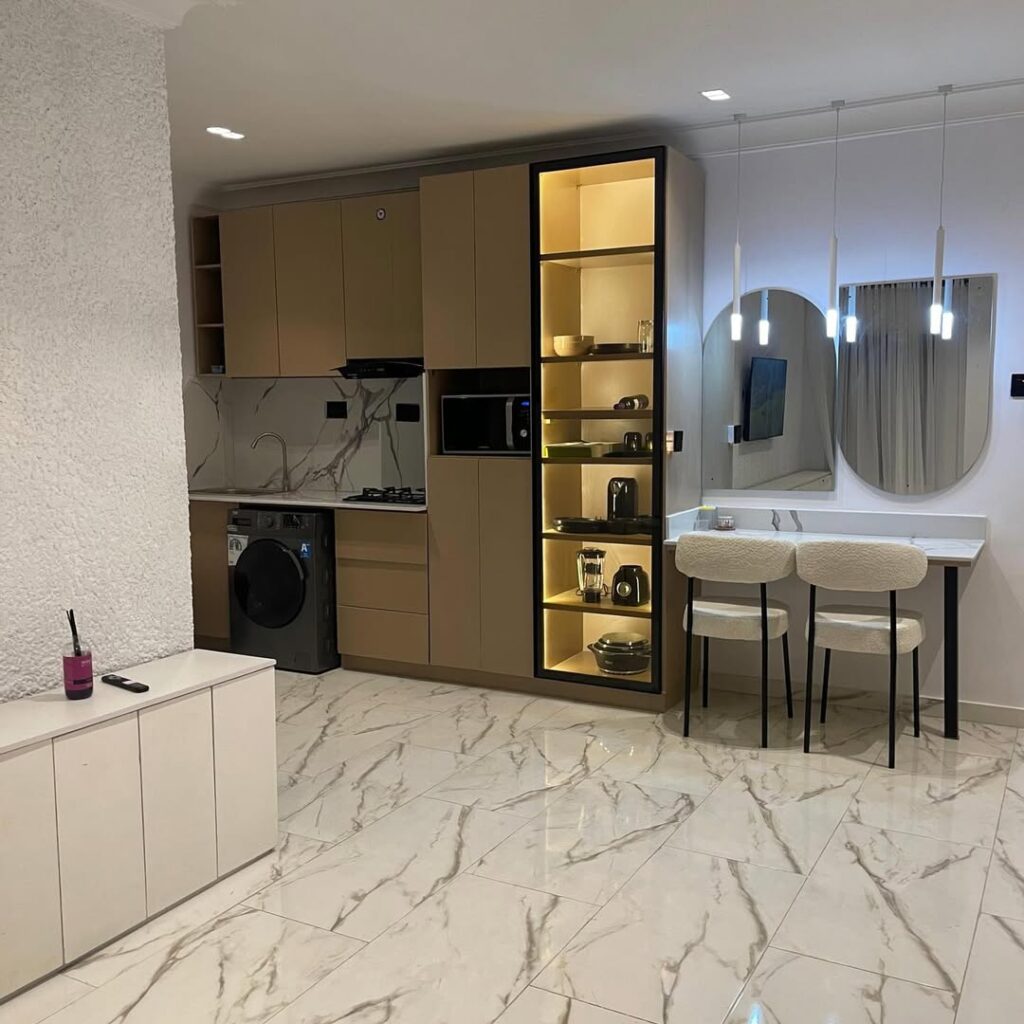
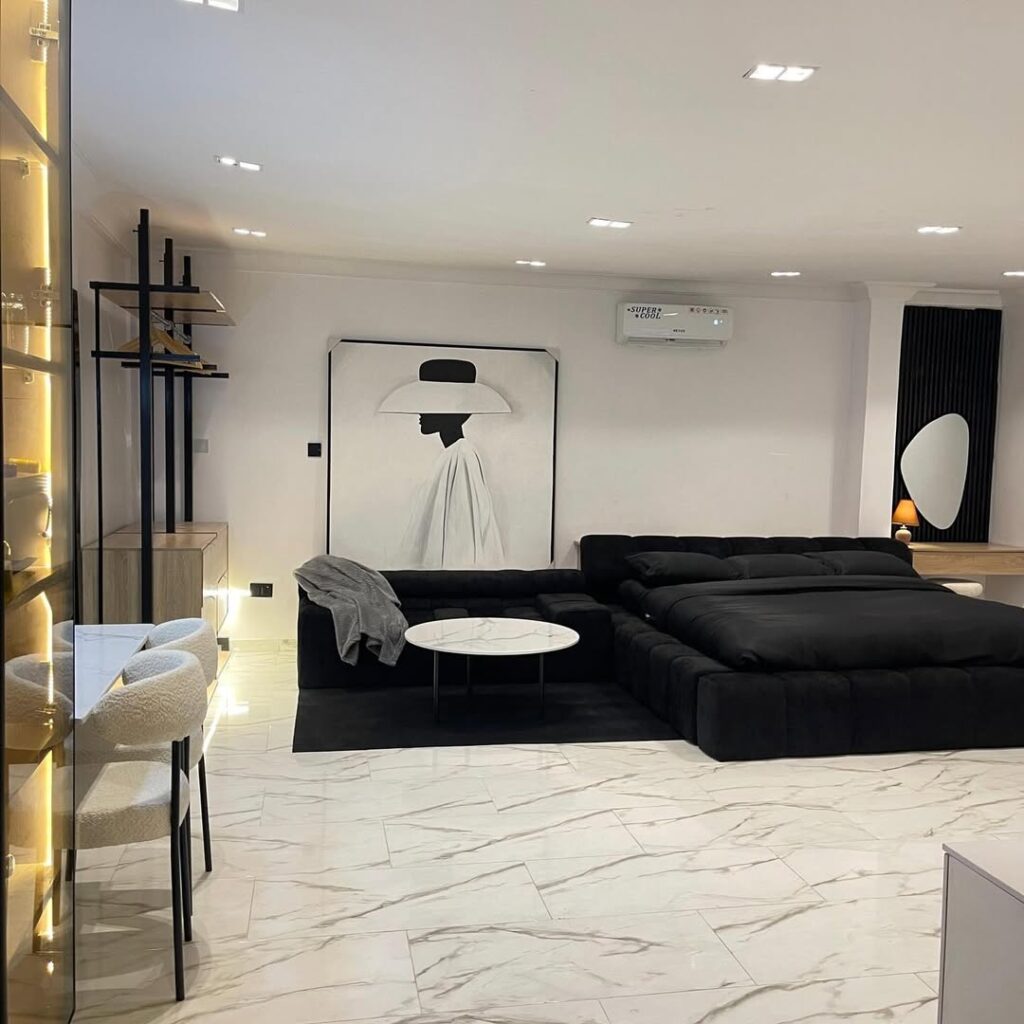
credit – @mide_elo
This studio takes minimalist design in a bold, sophisticated direction by pairing sleek monochrome tones with luxurious textures. The black sectional and bedding anchor the space, while the marble-like floors and high-gloss cabinetry add brightness and polish.
A built-in kitchen with under-lit glass shelving provides both form and function, offering open display without clutter. Nearby, a compact vanity setup with rounded mirrors and pendant lighting adds hotel-suite elegance while staying space-conscious.
The entire apartment feels curated and high-end without being busy. It’s proof that minimalism doesn’t have to mean “all white everything”—black, beige, and warm lighting can create just as calm and intentional a vibe, with a moodier edge.
This look is perfect for someone who loves simplicity with a little bit of drama.
8. Use Decorative Panels to Divide Without Cluttering
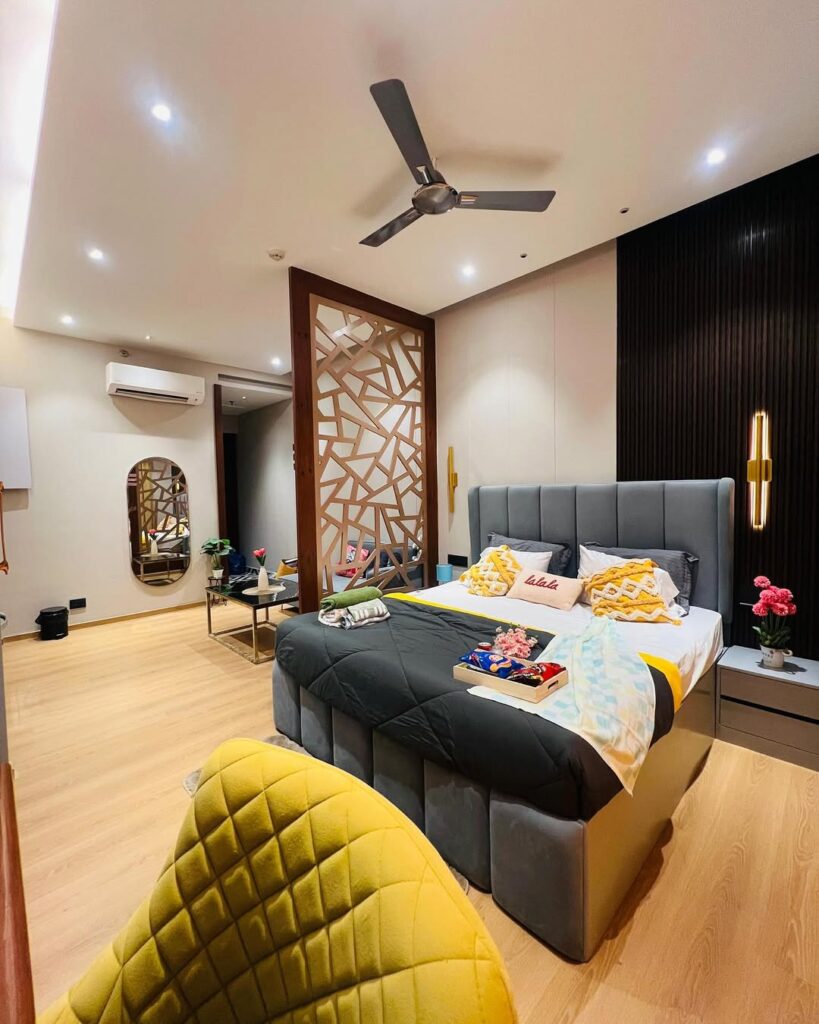
This studio strikes a perfect balance between style and function by using a decorative wood screen to subtly divide the sleeping area from the entry and living space. The panel features an abstract geometric cutout that provides privacy without feeling closed off.
Soft textures and bold accents—like the mustard yellow chair and layered bedding—add warmth and personality to the minimalist foundation. Meanwhile, built-in lighting and clean-lined furniture keep the space sleek and modern.
Get the Fail-Safe Paint Color Playbook (Free PDF)
36 proven colors • 8 ready palettes • trim & sheen guide • printable testing cards.
The bed’s upholstered base doubles as storage, proving that in a studio, every piece should work overtime. The result is a space that’s visually dynamic, functionally smart, and still beautifully uncluttered.
If you want to zone your apartment without walls or curtains, this kind of artistic screen adds just the right level of structure and flair.
9. Layer Bold Prints in a Clean, Curated Way
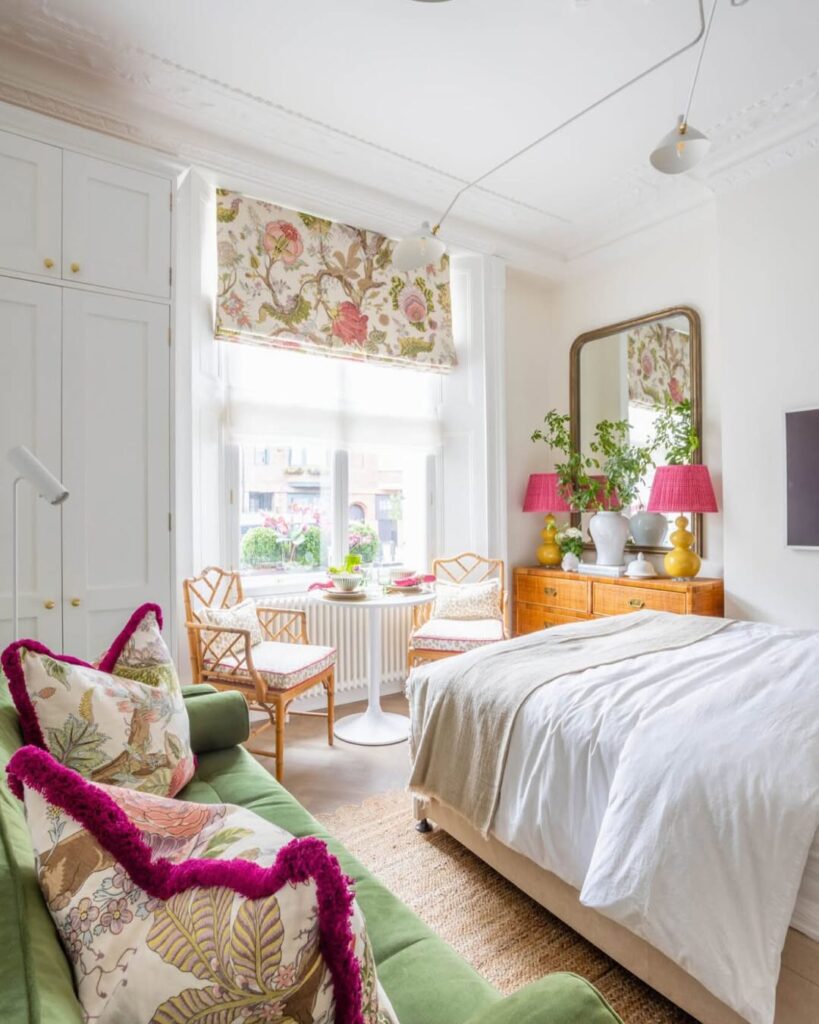
Who says minimalism has to be neutral? This studio proves that you can still embrace color and pattern while keeping things feeling intentional and uncluttered. The key here is balance—bold botanical prints are repeated in the Roman shades, throw pillows, and upholstery, but grounded by simple white walls and soft lighting.
The small round table by the window maximizes space for dining or working, while wicker chairs and a jute rug introduce natural textures that soften the bolder elements.
Built-in cabinets stretch all the way to the ceiling, offering generous storage without taking up precious floor space. It’s a brilliant way to maintain visual calm in a richly styled room.
This is minimalist maximalism done right: full of personality, but organized and thoughtfully layered—perfect for those who crave charm without chaos.
10. Streamline with Built-Ins and Vertical Texture

This studio apartment showcases how built-ins can completely transform a small space. Floor-to-ceiling cabinets, a stacked washer/dryer, and a fully integrated kitchen all line one sleek wall—freeing up the rest of the room for living and sleeping.
The neutral palette of white, gray, and wood tones keeps the look sophisticated and modern, while vertical wood slats behind the bed add warmth and visual height. It’s a small detail with a big impact.
The tufted velvet bench at the foot of the bed adds a touch of luxury and provides extra seating without taking up much space. Every element here is purposeful, functional, and visually cohesive—hallmarks of minimalist design done right.
This setup is perfect for anyone who wants maximum utility and style in a compact footprint.
11. Keep It Open with Low Seating and Clean Lines
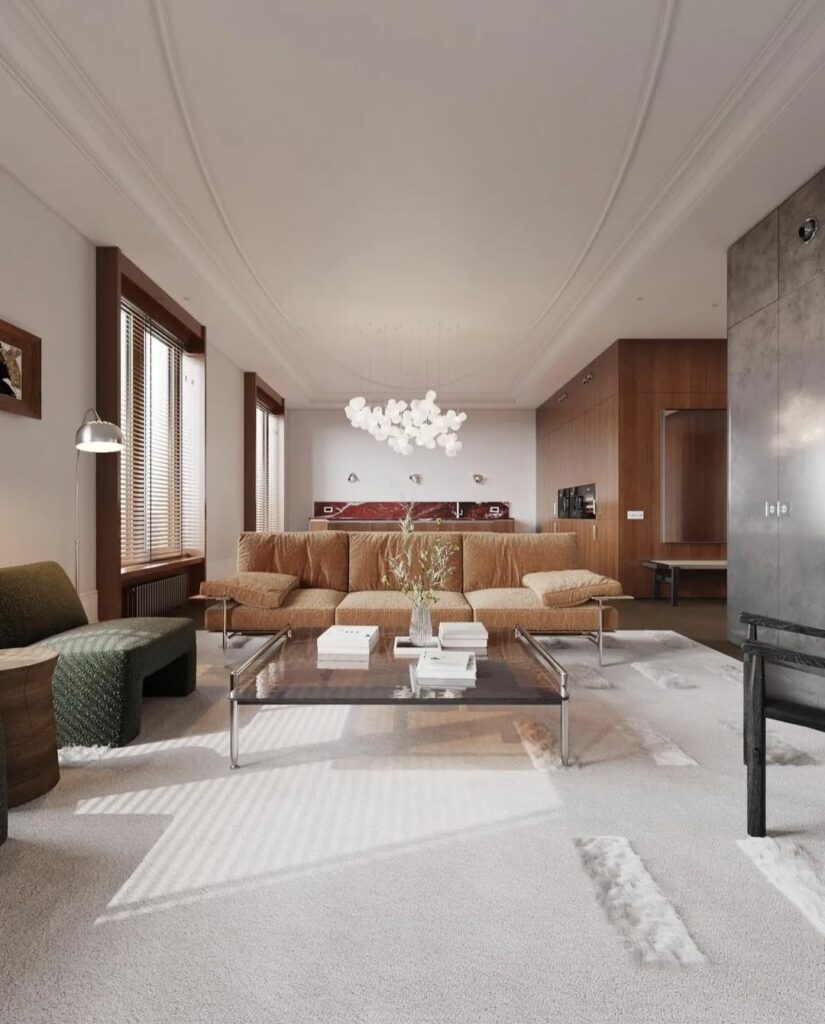
This studio uses low-profile, sculptural furniture to maintain an open, airy flow without sacrificing comfort or design. The plush sectional and curved green accent chair create a cozy living zone while allowing the eye to travel through the entire space uninterrupted.
A glass coffee table keeps things light and uncluttered, blending into the neutral rug and further enhancing the illusion of space. Clean lines and natural textures—wood, stone, and soft textiles—add warmth and visual depth without overwhelming the room.
Strategic symmetry in the layout, paired with natural light and layered lighting (like the cloud-inspired chandelier), gives this studio a serene, gallery-like quality.
This is a masterclass in minimalism with soul: calm, composed, and quietly luxurious.
12. Let Statement Art Anchor Your Layout
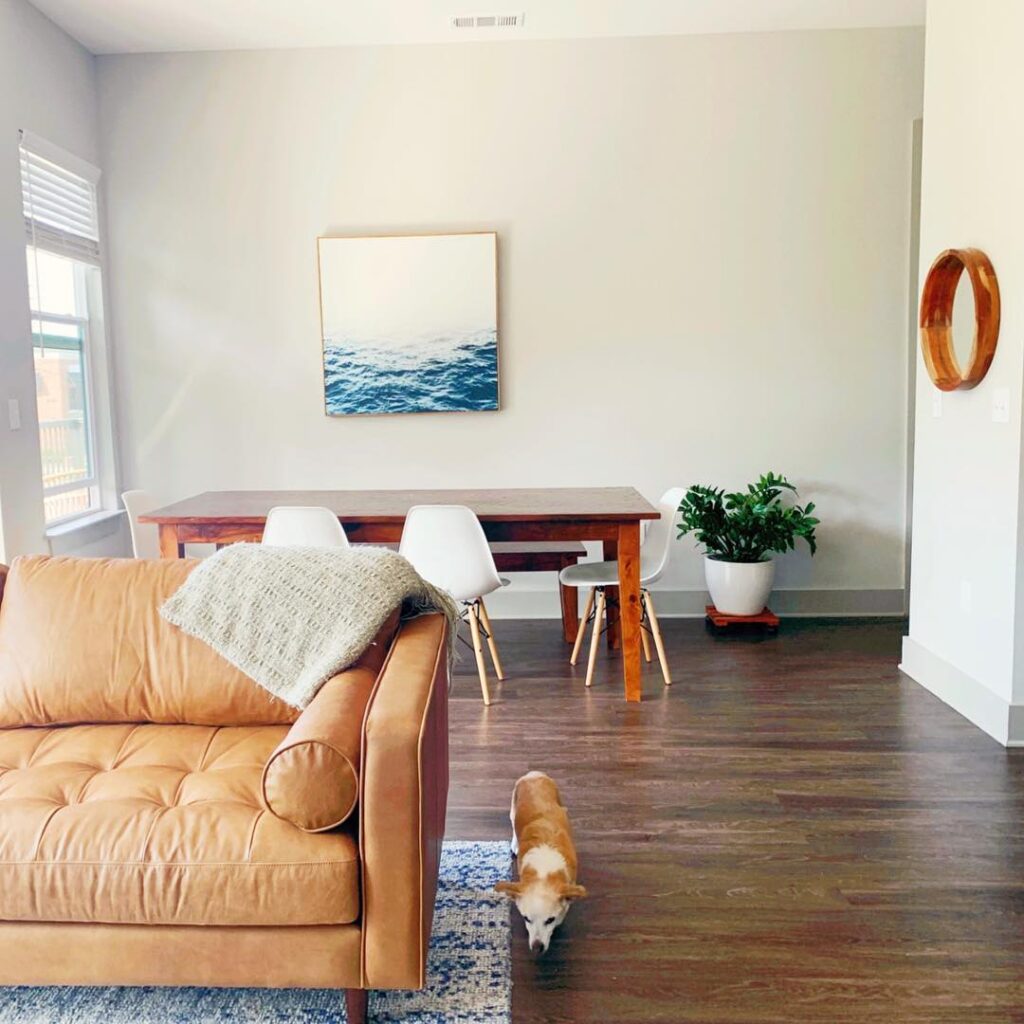
In a minimalist studio, where space is limited and every object matters, a single piece of statement art can do a lot of visual work. This space keeps things clean and open, while the ocean-inspired artwork brings depth, movement, and a sense of calm.
The furniture is kept low and streamlined: a caramel leather sofa, simple white dining chairs, and a warm wooden table. The overall palette feels coastal and grounded—light neutrals with pops of rich natural tones.
By placing the artwork above the dining table, the room gets a clear focal point without needing extra decor or clutter. One plant, one throw, one piece of art—and it all just works.
This is minimalist styling at its smartest: thoughtful, not bare; serene, not sterile. Perfect for those who want their studio to feel curated but still comfortable.
13. Opt for Built-In Dining in Open Layouts
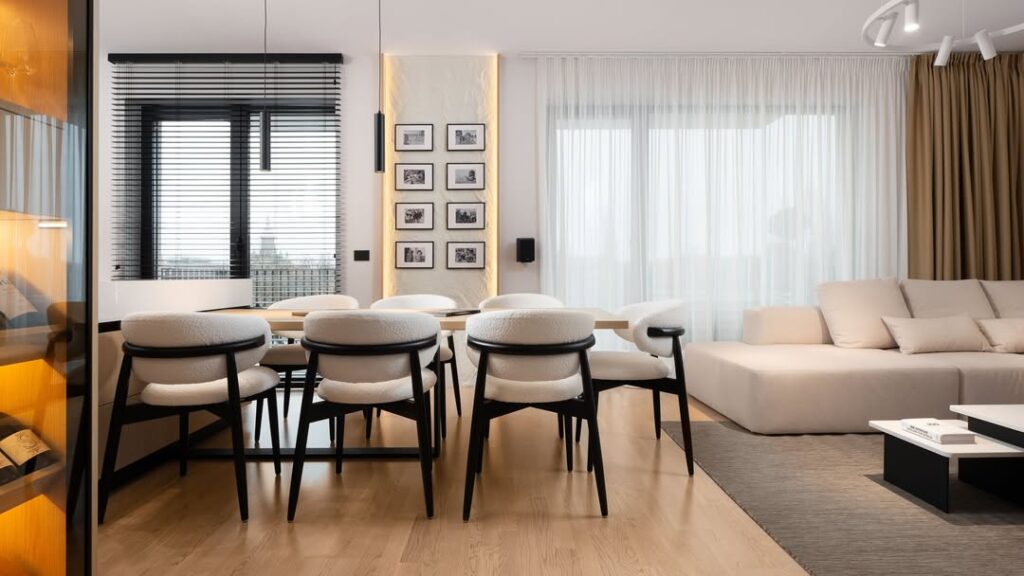
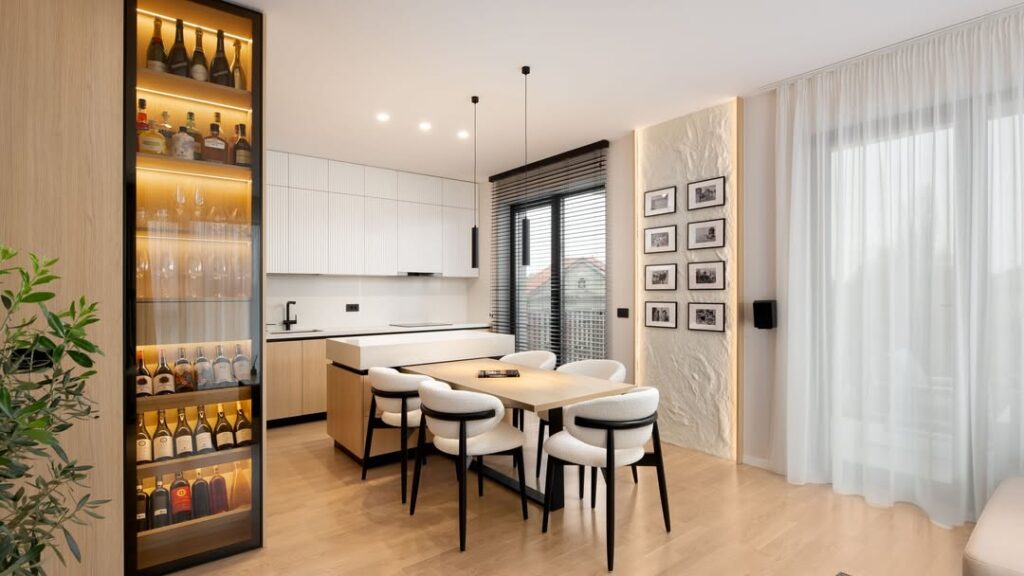
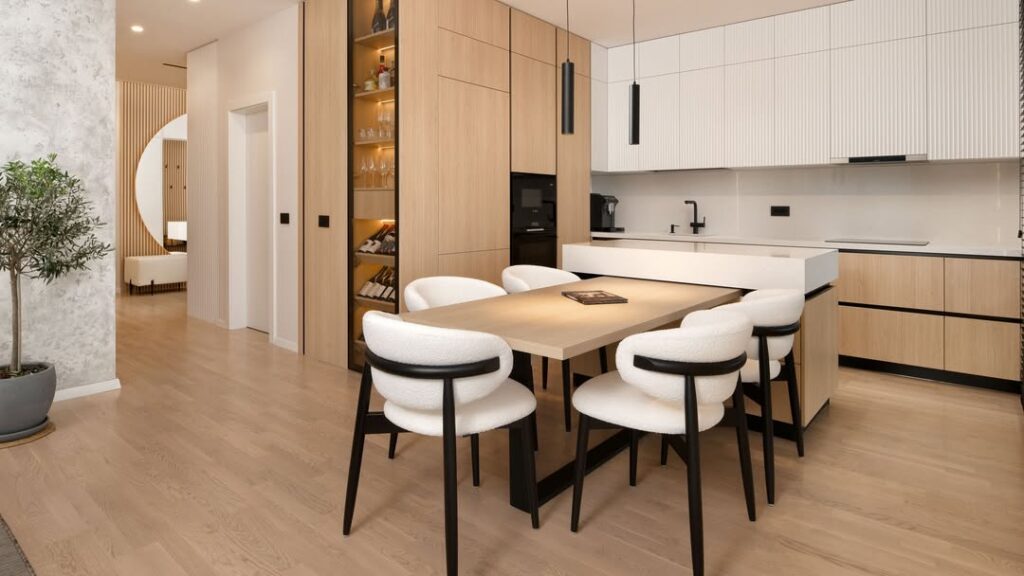
credit – @atmsf.design
In compact studio apartments, combining functionality with visual elegance is key—and this space does it flawlessly with a built-in dining setup that flows directly from the kitchen.
Get the Fail-Safe Paint Color Playbook (Free PDF)
36 proven colors • 8 ready palettes • trim & sheen guide • printable testing cards.
The dining table is seamlessly integrated into the kitchen island, allowing the layout to remain open and fluid. This eliminates the need for extra furniture, reducing visual clutter while still offering a full dining experience.
Warm wood tones, soft upholstered chairs, and matte black accents create a clean, modern aesthetic. The minimalist palette ties the dining, kitchen, and living zones together harmoniously, making the apartment feel larger and more cohesive.
Framed wall art and subtle lighting bring warmth and character without compromising simplicity. This layout is ideal for entertaining, eating, or even working—all while maintaining a minimalist approach to studio living.
14. Stick to a Monochrome Palette for Visual Unity
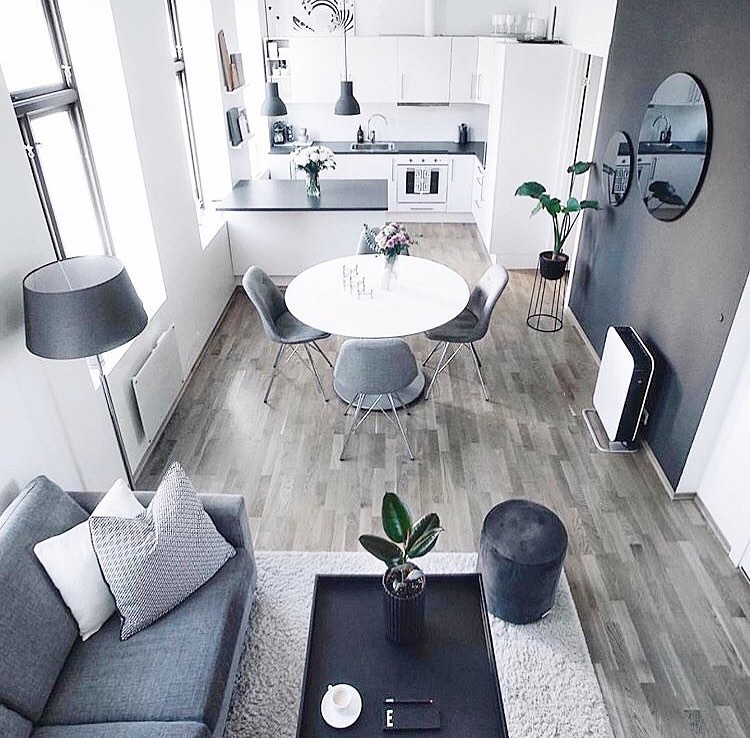
A monochrome color scheme can work wonders in a studio apartment by creating the illusion of space and cohesion. This modern space uses tones of grey, black, and white to craft a seamless flow from kitchen to living area.
By limiting the palette, each area feels connected yet defined. The white cabinets bounce light around the room, while darker accents like the circular wall mirrors and pendant lights add contrast and dimension.
A round dining table keeps circulation open, and the curved furniture shapes soften the angular layout—important in smaller spaces.
Touches of greenery and layered textures (like the rug and throw pillows) warm up the minimalist setup without interrupting its simplicity.
Monochrome doesn’t have to be boring—it’s a smart, stylish strategy that helps studio apartments feel calm, curated, and cohesive.
15. Embrace Natural Light and a Plant-Filled Workspace
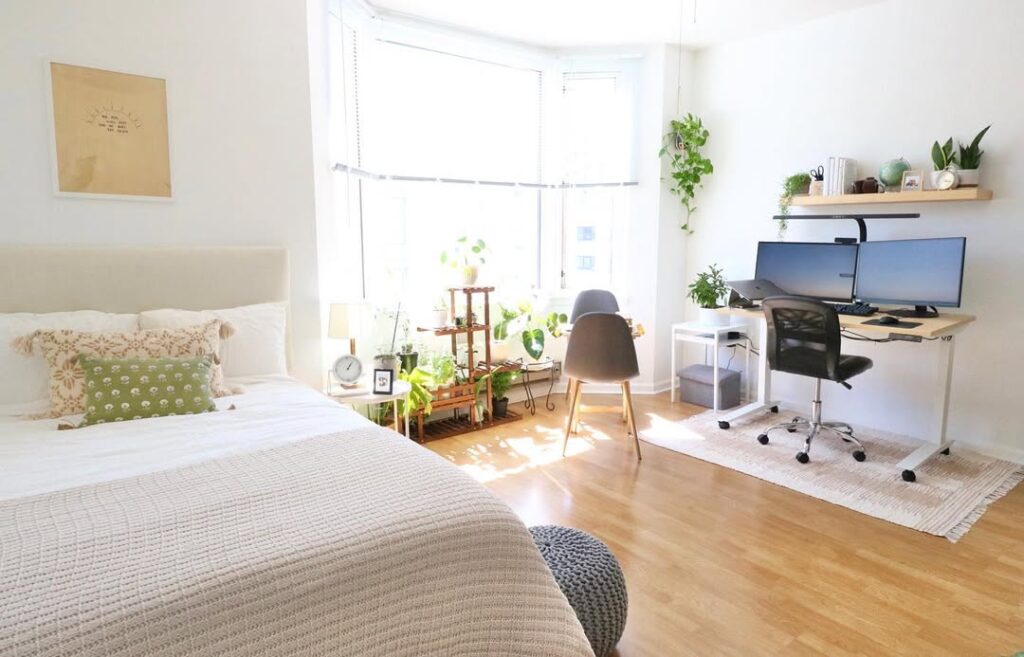
One of the best ways to make a studio apartment feel open and vibrant is to let in as much natural light as possible. This sun-soaked space maximizes every inch by placing the bed near the window and turning a sunny corner into a green oasis.
The combination of white walls and light wood floors enhances brightness and creates an airy foundation. A small desk setup with dual monitors fits neatly against the wall, turning this cozy corner into a productive work-from-home zone.
Indoor plants play a big role in softening the room and bringing a refreshing, biophilic touch. From trailing vines to potted foliage on tiered stands, the greenery adds life without clutter.
This layout proves that a studio apartment can be both a relaxing retreat and a functional workspace—especially when you design around natural light and keep your décor fresh and minimal.
How to Style a Minimalist Studio Apartment
Creating a cohesive and calming space in a studio begins with intentional design choices. Start by selecting a limited color palette—usually neutral tones with one or two accent colors. This helps maintain a sense of flow and visual simplicity throughout the space.
Invest in multi-functional furniture like a bed with hidden storage or a bench that doubles as a coffee table. Opt for clean-lined designs with minimal ornamentation. Keep surfaces clear and décor items to a minimum to avoid visual clutter.
Don’t forget texture—mix soft textiles like linen and wool with wood, glass, or matte metal to add warmth and depth without overwhelming the aesthetic.
Best Colors for a Minimalist Apartment
Color sets the mood in any minimalist interior. For a studio, consider sticking to soft whites, warm beiges, light grays, or creamy taupes as base tones. These shades enhance natural light and make small spaces feel larger.
You can introduce contrast with muted tones like olive green, rust, or dusty blue through soft furnishings and artwork. If you prefer a monochromatic palette, layer varying tones of the same color for subtle dimension.
Keep accent colors minimal and intentional—use them sparingly through throw pillows, plant pots, or a single statement artwork.
Furniture Ideas for Small Studio Spaces
Choosing the right furniture is key in a minimalist studio. Prioritize pieces that are both stylish and space-saving:
Get the Fail-Safe Paint Color Playbook (Free PDF)
36 proven colors • 8 ready palettes • trim & sheen guide • printable testing cards.
- Convertible sofas or daybeds: Function as both seating and sleeping areas.
- Drop-leaf or folding tables: Ideal for dining or working without occupying space full-time.
- Under-bed storage: Great for stashing seasonal clothes or linens.
- Wall-mounted desks or shelves: Keep the floor area open and maximize vertical space.
- Nesting coffee tables: Offer flexibility and tuck away easily when not needed.
Always opt for furniture that aligns with your minimalist color palette and clean design ethos.
Lighting Tips for Small Minimalist Spaces
Lighting has a major impact on how your studio feels. Maximize natural light by using sheer curtains or none at all. Position mirrors strategically to bounce light and visually expand the room.
Layered lighting adds depth. Combine a primary ceiling fixture with ambient floor lamps and accent lighting like wall sconces or table lamps. Choose warm white bulbs (2700K–3000K) for a cozy, inviting glow.
Opt for simple, sculptural light fixtures that double as decorative pieces—this way, you enhance both form and function without excess.
Common Mistakes to Avoid in a Minimalist Studio
Even with the best intentions, it’s easy to veer off course. Watch out for these pitfalls:
- Over-decluttering: Removing too much can make your space feel sterile and impersonal.
- Ignoring comfort: Minimalist doesn’t mean cold—incorporate softness through rugs, throws, and cushions.
- Lack of storage: Clutter piles up fast in small spaces. Use vertical and hidden storage solutions.
- Poor layout planning: Zones should feel intuitive—don’t block windows or walkways with bulky furniture.
- Forgetting personal touches: A minimalist studio should still reflect you. Choose a few meaningful items that spark joy.
